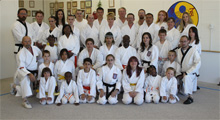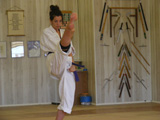What is Karate-Do
Karate-Do, the "Way of the Empty hand,"is the path to self-development. Karate is best known as a method of self-defense, but self defense is only a by-product of true Karate training. Karate-Do develops character through training, so that the practitioner learns to surmount any obstacle, tangible or intangible.
Karate-Do is open to all individuals, regardless of present physical condition. Conditioning will improve gradually through training and students are encouraged to progress at their own rate. Students are expected to expand their physical limits and increase their level of accomplishments, while at the same time using self-control to prevent overtraining which leads to injury.
In order to fully develop in Karate-Do, students must learn to work together for their mutual benefit. Etiquette is necessary for this phase of training. Respect must always be shown to one’s training partners and their needs. Respect in sparring means to give your partner strong training that will help to expand his/her abilities without trying to injure or humiliate. When training with lower ranking students, be respectfully instructive, not condescending. When training with a more experienced practitioners, challenge their abilities to your utmost.
At Complete Martial Arts, we teach the funamentals of Martial Arts by combining the time-tested Eastern philosophy of Martial Arts with the modern approach of Western teaching philosphy. We offer a well-balanced program for the adults and children emphasizing pride, self-esteem, fitness and integrity.
| Styles Taught at Our Dojo
|
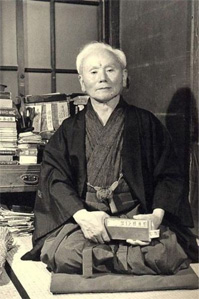
Master Gichin Funakoshi
Founder of Shotokan Karate
|
Shotokan Karate - Main Style
Shotokan Karate is a Japanese style of Karate founded by Master Gichin Funakoshi born in 1868. Master Funakoshi is regarded universally as the father of modern Karate. He brought together two systems of open-hand fighting that flourished in his native Okinawa to form a new system called Shotokan. Shotokan means “hall of Shoto,” Shoto being the penname of Funakoshi. Master Funakoshi continually edited, revised, and updated the various kicks, punches, strikes, blocks, and body dynamics until the day he died in 1957.
Shotokan actually began Master Funakoshi’s 1917 trip to Kyoto, where karate was demonstrated for the first time in Japan, at the Butokuden (Martial Virtues Hall). The demonstration was a success, but it wasn’t until March 6, 1921 that Shotokan Karate got its due. On that date, the Crown Prince of Japan visited Okinawa. Funakoshi was asked by the Department of Education to give a karate demonstration for him in the Great hall of Shuri Castle. The prince was so impressed that the Ministry of Education of Japan asked Funakoshi to perform at the first national Athletic Exhibition in Tokyo. Many prominent martial artists asked Master Funakoshi to stay in Japan and teach some techniques of Shotokan. He agreed to stay a few weeks, but ended up never going back to Okinawa. Thus, Shotokan Karate spread all over Japan and eventually to the United States. In 1935, Karatemen from all over Japan formed a committee that solicited funds to build a free-standing karate dojo.
Construction began in Zoshigaya, Toshima Ward in Mid-1935, and was completed in the spring of 1936. Master Gichin Funakoshi, at age 68, bowed and entered the world’s first karate dojo. As a tribute to him Karate students all over Japan, a plaque was hung over the door inscribed with the characters for “Shotokan,” (“the hall of Shoto”).
|
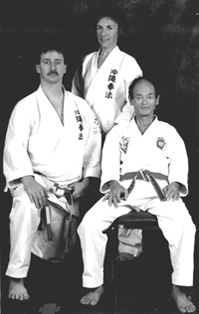
Hanshi Seikichi Odo
Founder of Okinawa Kenpo Karate-Kobudo
Hanshi C. Bruce Heilman & Hanshi Ann-Marie Heilman
Founders of the IKKF
|
Okinawa Kenpo Kobudo/IKKF - Secondary Style
Master Odo introduced weapons to the Okinawa Kenpo System in the early 1970's, resulting is what is now known as Okinawa Kenpo Karate-Kobudo. Master Odo is ranked as a Judan (10th Degree Black Belt in both Karate and Kobudo, and is considered one of the top Weapons practitioners in the world today. Master Odo served as a member of the IKKF Executive Board from its inception in 1991 to March 1999. Master Odo passed away on March 24, 2002 in Okinawa, Japan.
Hanshi C. Bruce heilman & Hanshi Ann-Marie Heilman trained under and remained close to Master Odo up to his passing. With the Introduction of the IKKF, it allowed a stand alone Kobudo Program for other Dojos to train in. They serve as the Head of the organization and over see the rank promotions of the IKKF Members, the the goal being "Preserving the Old Ways". Sensei Christopher Weis has been training in Okinawa Kenpo Kobudo since the mid 1990's. We remain in close contact with Hanshi Heilman's as well as the IKKF New Mexico State Representiative Cassandra Shults to continue our instruction in Kobudo.
This form of weapons training includes the 6 major Okinawan Weapons:
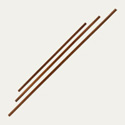
Bo |
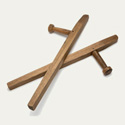
Tunfa |
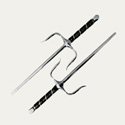
Sai |
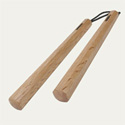
Nunchaku |
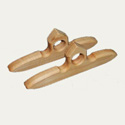
Tekkos |
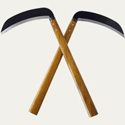
Kama |
Students who show the aptitude and dedication for such training will have this available to them once they reach the rank of 8th Kyu (High Orange Belt).
Students ranked of 8th Kyu (High Orange Belt) to 1st Kyu (High Brown Belt) will begin training Kobudo in this order of weapons: Bo, Tunfa, Sai, Nunchaku.
Students Shodan (1st Degree Black Belt) or higher will begin training in Tekkos followed by Kama.
|
|


